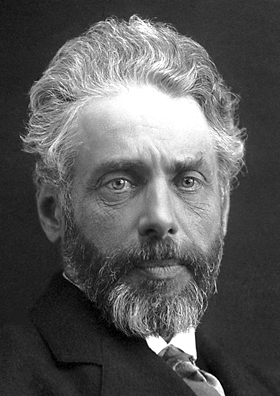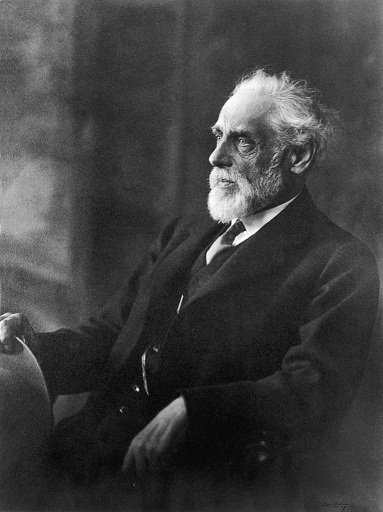<Back to Index>
- Banker and Military Theorist Jan Gotlib Bloch, 1836
- Writer Henrik Pontoppidan, 1857
- Governor of New York and Secretary of the Treasury John Adams Dix, 1798
PAGE SPONSOR



Henrik Pontoppidan (July 24, 1857 – August 21, 1943) was a realist writer who shared with Karl Gjellerup the Nobel Prize for Literature in 1917 for "his authentic descriptions of present - day life in Denmark." Pontoppidan's novels and short stories — informed with a desire for social progress but despairing, later in his life, of its realization — present an unusually comprehensive picture of his country and his epoch. As a writer he was an interesting figure, distancing himself both from the conservative environment in which he was brought up and from his socialist contemporaries and friends. He was the youngest and in many ways the most original and influential member of the Modern Break - Through.
The son of a Jutlandic vicar and belonging to an old family of vicars and writers, Pontoppidan gave up an education as an engineer, worked as a primary school teacher and finally became a freelance journalist and full time writer, making his debut in 1881.
The first phase of his work constitutes rebellious social criticism, and as such was also a revolt against his own privileged family background. In a famous quote, Henrik Pontoppidan mocked the historic latinization of his own surname Pontoppidan from its original Danish root Broby.
In
matter - of - fact short stories he mercilessly describes the life of the
peasants and country proletarians, with whom he lived in close contact.
He was perhaps the first Danish progressive writer to break with an
idealised portrayal of farmers. The tales from this era are collected in Landsbybilleder ("Village Pictures", 1883) and Fra Hytterne ("From the Huts", 1887). An important part is his 1890 political collection of short stories Skyer ("Clouds"),
a biting description of Denmark under the authoritarian semi - dictatorship of the Conservatives both condemning the oppressors
and scorning the Danes’ lack of disaffection. After this period he
increasingly concentrated on psychological and naturalist problems
without giving up his social engagement. Pontoppidan's 1889 review
"Messias" and 1890 piece "Den gamle Adam" were anonymously published
and triggered a controversy after being denounced as blasphemous. The editor, Ernst Brandes, was fined 300 kroner for "Messias" in December 1891 and committed suicide in 1892. The
three novels which are normally considered to be Pontoppidan’s main
works were written from about 1890 to 1920. In these works he
established on his own terms a Danish version of the "broad description
of society" novel in the tradition of Balzac and Zola.
Centered around a hero he paints a picture of Denmark in the era of the
Constitutional Struggle between Conservatives and Liberals, rising
industrialisation, cultural conflicts and awakening revolutionary
movements. Pontoppidan's last large novel Mands Himmerig (1927, "Man’s Heaven") is an almost desperate description of the crisis of a Danish intellectual at the time of the outbreak of World War I. Pontoppidan also wrote many short novels and long tales in which he discussed political, psychological and sexual themes. Isbjørnen (1887, "The Polar Bear") describes the confrontation between an outspoken vicar from Greenland and his narrow - minded Danish provincial clergymen. Mimoser (1886, Engl. transl. The Apothecary’s Daughters, 1890) is an ironic - tragic tale about the exaggerated intolerance of unfaithfulness. Nattevagt (1894, "Night Watch") deals with a courageous and revolutionary artist who is nevertheless a frustrated failure as a husband. Den gamle Adam (1894, "The Old Adam") deals with both men’s fear of women and of sexuality as a whole. "Borgmester Hoeck og Hustru" (1905, Engl. transl. Burgomaster Hoeck and His Wife, 1999) portrays a tragic marriage dominated by the husband's jealousy and dislike of his wife's joy in life. A
central theme in most of these tales is the difficulties of handling
the new tolerance, open - mindedness and democratization which are
introduced by both the transition of society and by literature. Another
theme is the conflict between the introverted and closed male nature
and the vitality of the woman. Behind all this lies the classic
naturalist theme of heritage and milieu against which man has to rebel
without quite denying their existence. In his later works he sometimes
seems to become a mixture of a castigator of society and a prophet of
doom. Between 1933 and 1943 Pontoppidan wrote two different versions of his Memoirs,
in which he tried to define his own view of his personal development.
Though handicapped by blindness and deafness in later life, he
continued to take an interest in politics and cultural life until his
final years. As a stylist Pontoppidan has been described a born naturalist. His
language looks plain, simple and easy but is often loaded with symbols
and secret hints, hidden irony and “objective” descriptions. He often
revised previous works, simplifying them but also changing their plot
or sharpening their attitude. In
spite of being well known as a man of positions and attitudes
Pontoppidan remains one of the most discussed modern Danish writers.
This is partly because of his personal character. Pontoppidan was a man
of many paradoxes: a clear liberal in his time, but a stern patriot, an
anti - clerical puritan, a disillusioned fighting nature, collaborating
with socialists but always from an independent and individualist
position. But it is also partly due to his style which has often been
regarded as ambiguous and impenetrable; his mixture of partiality and
objectivity has often confused both readers and critics and in fact
liberals, radicals, conservatives, right wingers and socialists have
all tried to reflect their own ideals in his works. He has been regarded both as the absolute antagonist of Georg Brandes and as his most congenial pupil. Among
all the authors of the Modern Break - Through, Pontoppidan is probably
the most influential and longest living. His social critical writings
mark him as a pioneer of 20th Century Danish literature. Cultural
conservatives have been inspired by his critique of modernism after
World War I. Finally, he set a standard of "novels about society" which
remains relevant. Pontoppidan's brother's daughter - in - law was the famous Danish actress Clara Pontoppidan. Pontoppidan's brother, Knud Pontoppidan was a famous psychiatrist and doctor. Pontoppidan was related through his family with the famous pietistic priest Erik Pontoppidan. Pontoppidan is buried in his family's grave site in the cemetery of Rørvig Kirke. The name Pontoppidan is latinization of the Danish surname Broby, literally translated into Bridge (by the) City, or in Latin, Pons Oppidum. Henrik Pontoppidan mocked this practise, which had taken place in the
17th century, as "the bad idea from educated people's custom, to
decorate their good Danish name with a Latin Adrienne," (a female dress
worn at the time for dances) "a ridiculous Peacockish plumage".